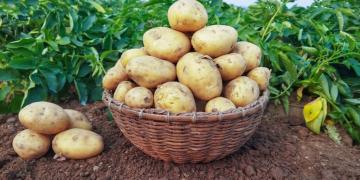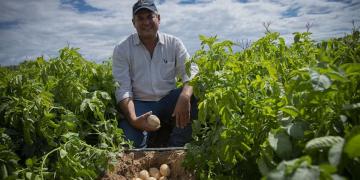Canadian potato industry on the upswing
A weaker loonie and promotion of potatoes prepared in more healthy ways are improving prospects for growers and processors

After several years of challenging times, the Canadian processing potato industry is feeling a lift, in part due to a lower loonie. It’s stimulated exports of french fries and other processed products as well as fresh potatoes to the United States and other markets, and for the first time in years some processing plants in Canada are expanding their production lines.
Kevin MacIsaac, general manager of the United Potato Growers of Canada, says most of the big processing companies like McCain and Simplot have plants on both sides of the border and will move production around to gain the most benefit from currency fluctuations. Recently, this has been helping Canadian producers.
“The way the dollar is now, (the processors) can run their plants harder in Canada,” he says. “In the past, when the dollar went the other way, they ran their plants harder in U.S. and perhaps were under capacity in Canada.”
Generally, though, the past 10 to 15 years have been tough for the Canadian potato industry. Not only has demand for fresh spuds and processed potato products been flat to diminishing, producers have faced ferocious competition from prime growing areas like Idaho and Washington in the U.S. and northwest Europe. As a result, there are a lot fewer people growing potatoes in Canada today than there were a decade or two ago.
“The numbers of growers have probably contracted, I would say, by about a third over the past 10 to 15 years,” says MacIsaac.
Statistics Canada estimates about 347,000 acres of potatoes were grown in 2016 — considerably less than the peak of 457,500 acres in 2003.
While there are fewer potato farms, the operations that remain are larger than ever. According to MacIsaac and other observers, there’s a trend towards amalgamation, caused by such factors as high input costs and thinning margins that encourage increased efficiencies and economies of scale, which mirrors what’s going in agriculture in general.
MacIsaac says processing companies tend to want to deal with fewer growers these days. More joint ventures and grower partnerships are being formed, he says, which “allows the plant to only have to deal with one voice at the other end of the phone with regard to scheduling loads, food safety regulations and that sort of thing.”
Three consecutive yield records
Even though there are fewer potato operations, crop production and yields have been rising, particularly in Western Canada, thanks to improved tools, technologies and management practices.
According to UPGC figures, total potato production in Canada this year was 105,172 cwt, a half per cent increase from 104,624 cwt in 2015 and almost 4.5 per cent higher than the 2014 total of 100,654 cwt.
The average yield in Canada is also high — higher than ever, in fact. UPGC pegs the national yield in 2016 at 307 cwt per acre, up from 305 cwt in 2015 and 294 cwt in 2014. It’s the third straight year of record-breaking potato yields for Canada.
“Some of that is related to where potatoes are grown in Canada,” says MacIsaac.
For example, Alberta and Manitoba, where much of the potato acreage is irrigated, produced excellent crops and record yields in 2016. In Central and Eastern Canada, where irrigation is limited, results were mixed last year. Quebec and Atlantic Canada produced generally good potato crops, but in Ontario production was way down (17.2 per cent according to UPGA figures) in 2016 due to a really dry sum mer and near-drought conditions in some areas.
Peter VanderZaag of Sunrise Potato in Alliston, Ont., acknowledges 2016 was a tough year but is confident Ontario’s potato producers will bounce back.
“Farmers are resilient,” says VanderZaag. “We take the bad years with the good ones.” While growers face different weather challenges from year to year, declining or flat demand has been a persistent growth barrier for many years now.
Competing for the shopping basket
Keith Kuhl is president and CEO of Southern Potato in Winkler, Man., and is also president of the Canadian Horticultural Council. He cites declining consumption of fresh potatoes is an important factor but also stresses there’s a lot more competition for consumer dollars these days.
“We’re also competing with a lot more SKUs (shelf space) in the grocery store. Ten or 20 years ago the number of products that were available in the produce section was relatively limited. Today, there’s a huge variety of products that potatoes are competing with,” Kuhl says.
“As producers, we have to become much more aware of what the consumer trends are, and then find ways to ensure that we’re meeting them.”
At a national level, there have been a number of recent promotional efforts organized by the Canadian Potato Council, a subgroup of the CHC.
In 2016, the CPC helped sponsor a pair of potato-related videos featuring renowned chef Michael Smith that were part of a campaign called “Half Your Plate,” aimed at encouraging Canadians to eat more fruit and vegetables. The Half Your Plate videos followed the successful completion of a national promotion campaign featuring potato recipes that ran in Chatelaine and Today’s Parent magazines and websites in 2015. The CPC is also currently looking into establishing a national organization that would include potato promotion as part of its mandate.
“We are looking at trying to set up a national research and promotion agency in Canada which would allow us to raise funds for research and promotion at the national level,” Kuhl says. “We have engaged with a firm in Ottawa to continue the discussion so hopefully sometime in the next year we’ll be able to develop a position.”
Which products to promote?
Kuhl acknowledges that raising enough money to set up and run such an agency is an important question. “That’s certainly always part of the discussion — who pays, and what are the funds used for,” he says. In addition to efforts at the national level, different grower organizations in the potato-producing provinces actively promote fresh potatoes, most notably the Prince Edward Island Potato Board.
Kendra Mills, marketing director with the P.E.I. Potato Board, says a new packaging program recently introduced to enhance the already strong “P.E.I. Potatoes” brand is paying off, and there are plans to introduce a few more tools to the marketing tool box for retailers and other dealers. In addition, the board is relying more and more on social media platforms like Facebook and Twitter to spread positive messages about the health benefits of potatoes and other attributes. “We’re really focused on social media. We see a lot of really great success from that,” Mills says.
Mills notes there’s lots going on in other parts of the country as well, with marketing groups like Manitoba’s Peak of the Market and businesses like Little Potato Company in Alberta and Ontario’s EarthFresh Foods developing innovative products and finding creative ways to promote potatoes with consumers.
“There are a lot of people doing a lot of really great things. You don’t have to look too far,” she says. “The retailers are recognizing the importance of potatoes — it’s still the number one vegetable consumed, and there’s still a lot of ways to push the category.”
One way to push potatoes is to develop and promote table varieties that appeal to consumer tastes with respect to size, appearance and flavour, a marketing strategy that’s well established in Europe but is relatively new in Canada.
“In Europe virtually every bag of potatoes in retail now will be identified by variety and we’re just starting to see some of that happen in Canada,” says Kuhl. “With better communication between the producer and the retailer that will continue to change. The North American market tends to be a decade to a decade and a half behind the European market on marketing trends anyway.
Fuente: http://www.country-guide.ca/2017/02/03/canadian-potato-industry-on-the-upswing/50304/








